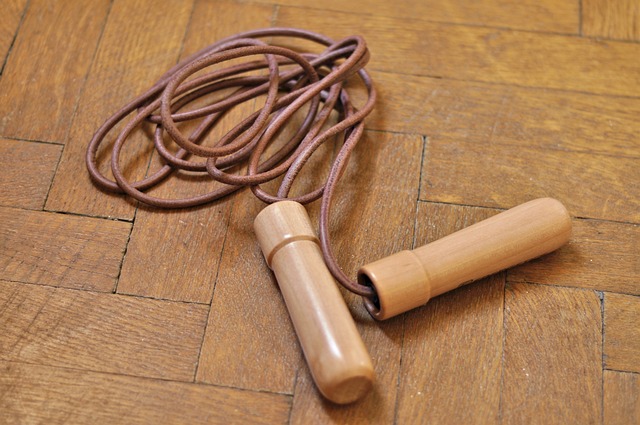We have a program that simulates an MMA workout you can do at home created by Chris Camozzi, who is a veteran UFC fighter.
You don’t need to be a professional martial art fighter to go a few rounds at home. Still, an MMA(mixed martial art) workout developed by a professional boxer may be beneficial.
If you don’t have a heavy bag or gloves, try the “bonus round”—it’s an equipment-free circuit workout meant to imitate the heart rate variations experienced by MMA fighters after a huge fight.
To kickstart your conditioning regimen, you would need a heavy punching bag, boxing gloves, hand wraps, and a jump rope.
Jump Rope
Because it combines aerobic training with agility, speed, and coordination, jumping rope is a good technique to elevate your heart rate (which is necessary at the start of your workout).
Camozzi agrees that it can be difficult for beginners. If you’re new to jumping rope, he recommends starting with five 1-minute rounds with a 1-minute pause in between.
As he puts it, “You want it to be demanding but not so difficult that it stops your workout. When you first start exercising, find a balance based on your fitness level.”
Option for Beginners
- 1 minute of rope jumping
- 1-minute break
- Rep five times more
Intermediate option
- 3 minutes of jumping rope
- 1-minute break
- Rep five times more
For the Advanced Option
- 5 minutes of rope jumping
- 1-minute break
- Rep five times more
After finishing your jump rope rounds, take a drink break, wrap your hands, and put on your gloves. Make this break as short and as efficient as possible.
Shadowbox
Depending on how much time you have, the shadowboxing element of your workout is optional. Shadowboxing is simple: you spar with an imagined partner, throw punches and move around an imaginary ring.
However, just because it’s a simple workout doesn’t mean you should dismiss it. Camozzi emphasizes the need to push oneself and practice at a rapid tempo with fast punches and lots of footwork.
“You’ll feel it in your legs after the shadowboxing, and that’s exactly what we’re going for,” he explains. “Visualize yourself fighting in the ring. There will be no dropping your hands or roaming around throwing a few combos here and there.”
Camozzi usually does two to three 5-minute rounds of fast-paced shadowboxing and movement. If you’re pressed for time, you can do a single 5-minute round. You can even eliminate it entirely from your program and go straight to the heavy bag workout.
Every Level
- 5 minutes of fast-paced shadowboxing
- 1-minute break
- Rep up to three times more.
Work with Heavy Bags
Heavy bag work can be done alone or with a partner. Camozzi’s heavy bag regimen consists of three 5-minute rounds separated by a 1-minute recovery period. Each round is dedicated to a different component of training.
Start with a 5-minute round of hands-only boxing. This should be done quickly with a high volume of blows.
The second, 5-minute round functions similarly to the first but focuses only on kneeing and kicking actions rather than boxing. Alternate between high and low kicks.
The goal is to keep the pace fast and the volume high for the full 5-minute round, but you can become creative as you go.
Everything comes together in the third 5-minute round, which combines striking and kicking. This will weary you, but try to maintain your intensity—only it’s 5 minutes of effort altogether.

Throughout the round, try to throw all combos and alternate between speed and power. Burn those muscles and lungs with high, low, strong, rapid, double-up strikes.
Allow yourself a minute to rest between each of the five-minute rounds. Depending on how you feel, you can consider this as absolute rest or active rest. Camozzi does core work during his minute-long “breaks”: “I wrap my legs around the bag and do sit-ups with two light punches at the top of each sit-up.”
After completing all three rounds, take a 2- to 3-minute water break before continuing.
Every Level
- Punching round of 5 minutes, quick tempo, and high volume
- 1-minute break (active or passive)
- 5-minute kicking round with a quick speed and high volume
- 1-minute break (active or passive)
- Fast-paced and high-volume 5-minute kicking and punching round
- Rest for 2-3 minutes and take a water break
The Burning Round
The burnout round is similar to a final, high-intensity struggle between you and the bag. You can do this alone or with a partner; however, most workouts are more fun (and tough) with someone pushing you. “If you do it alone, you have to really challenge yourself,” Camozzi says.
Every Level for MMA Exercise
Set an interval timing app to time five 30-second work/30-second rest intervals.
If you do the workout without a partner, you will push yourself as hard as you can throughout the 30-second work period and then relax for 30 seconds.
If you’re working with a partner, simply switch off, with one of you working during the work interval and the other working during the rest interval:
- Punch as fast and hard as you can for 30 seconds.
- 30 second break (or your partner performs their work interval)
- 30 seconds of quick and powerful kicks followed by 30 seconds of rest (or your partner performs their work interval)
Repeat three times.
Push-ups and core exercises
If you have time, do two to three sets of push-ups, doing as many as you can for each set while maintaining proper form, and then end with a series of ab exercises such as planks, sit-ups, medicine ball oblique twists, and leg lifts. Take advantage of this opportunity to work on your chest and abs. Adding 5 to 10 minutes is an excellent way to end.
The Equipment-Free Conditioning Circuit for MMS Workout.
There is a solution if you don’t have access to a heavy bag or require a workout that you can do in a hotel room or tiny space.
According to Matt Marsden, a fitness instructor at Beacon College in Leesburg, Florida, with a training and coaching background in Brazilian Jiu-Jitsu, Judo, boxing, Muay Thai, and Tae Kwon Do, this workout is common for MMA fighters because they travel frequently and must train outside of the typical gym setting.
Marsden also emphasizes that bodyweight conditioning activities are just as crucial for MMA training as punching in the ring.

“If there’s one thing you can definitely count on in this sport, it’s that your pulse rate will change numerous times within a 5-minute round due to the variety of fighting styles. It may begin as a boxing battle, progress to Olympic-level wrestling, and then return to the feet “Marsden explains. “To train in this manner, take the concept of rep schemes, ball it up, and throw it away. There are no more reps, only timed rounds.”
Fighting your way through a number of timed conditioning rounds is an effective method to simulate the training regimen used by MMA fighters.
As an example, Marsden suggests the following workout:
- Push-ups in one minute
- Mountain climbers in one minute
- One minute plank
- Burpees in one minute
- Crunches for one minute
Rest for 1 minute after completing the 5-minute round (exactly as in an MMA bout), then repeat to complete the cycle three times.
Marsden recommends finishing with a high-intensity interval round after the three bodyweight rounds. Perform 5-10 30-second work/30-second rest intervals, sprinting or jumping rope as fast as you can for the 30 seconds of work.
When planning your bodyweight circuit, alternate between higher- and lower-intensity workouts.
To Conclude
There is no MMA exercise at home that can truly replicate the adrenaline rush of fighting another fighter. If you’re serious about learning mixed martial arts, look for a facility that has trainers who can teach you the exact abilities you’ll need to fight your way through three grueling rounds.
It’s not only about hitting hard or kicking hard—you also need to know how to grapple and wrestle, break out of clutches, and take a punch without flinching. While they might be beneficial, home-based workouts can only take you so far in your MMA journey.

